Exploring the Exhaust Emission and Efficiency of Algal Biodiesel Powered Compression Ignition Engine: Application of Box–Behnken and Desirability Based Multi-Objective Response Surface Methodology
Abstract
:1. Introduction
2. Materials and Methods
2.1. Setup for the Test
2.2. Test Fuel
2.3. Design of Experiment and Data Collection
2.4. Experimental Uncertainty Analysis
2.5. Development of Predictive Correlation
2.5.1. Analysis of Variance (ANOVA)
+0.00047L2 − 0.066 CR2 − 0.000860BR2
+0.096947CR × BR − 9.74E−003L2 − 148.07CR2 − 0.11BR2
+0.537CR × BR − 0.059L2 − 347.74CR2 − 0.334BR2
−0.000009L × BR −0.000168CR × BR −0.000164L2 − 0.033CR2 + 5.57E− 005BR2
+ 0.29L2 + 7.46CR2 − 0.072BR2
2.5.2. Predictive Model Evaluation Using Statistical Indices
2.5.3. Model Uncertainty Measurement
3. Results and Discussion
3.1. Predictive Model Evaluation
3.1.1. Combustion and Performance Models
3.1.2. Engine Emission Characteristics Models
3.1.3. Uncertainty Analysis of Predictive Models
3.2. Interactive Effects of Control Variables on Response Factors
3.2.1. Brake Thermal Efficiency
3.2.2. Brake Specific Fuel Consumption
3.2.3. Exhaust Emission
4. Optimization and Validation
4.1. Optimization Using Desirability Approach
4.2. Validation of Optimized Conditions
5. Conclusions
- With only 17 experimental tests, a reliable and efficient model was developed. It is noteworthy because three control variables and five response variables were employed at three levels.
- The high R and R2 values (close to 1) achieved for all the prediction models with low prediction errors indicate an excellent degree of prediction ability of MORSM.
- The generated model’s Nash–Sutcliffe efficiency was in the range of 0.965–0.9988, suggesting a stable model. In addition, the mean absolute percentage deviation was modest (0.7–4.4%).
- The engine operating condition was optimized using the desirability technique. An optimum condition was reached with the engine load at 81.2%, compression ratio at 17.5, and with 10% biodiesel blends. The trade-off resulted in optimal combustion performance with low emission. The best performance output was obtained as 30.14% BTE, 307.36 g/kWh BSFC with exhaust emission CO2 as 1030.99 (g/kWh), PM as 0.429 (g/kWh), and NOx as 1261.75 ppm.
- An experimental test was used to confirm the output anticipated under optimal conditions. The predictions were all within 7.29% of the experimental findings.
Author Contributions
Funding
Institutional Review Board Statement
Informed Consent Statement
Data Availability Statement
Acknowledgments
Conflicts of Interest
Abbreviations
| AI | Artificial intelligence |
| bTDC | Before top dead centre |
| BTE | Brake thermal efficiency |
| CFD | Computational fluid dynamics |
| GHG | Greenhouse gas |
| MAPD | Mean absolute percentage deviation |
| NSE | Nash-Sutcliffe Efficiency |
| SDG | Sustainable development goals |
| FFA | Free fatty acid |
| FIT | Fuel injection timing |
| ICE | Internal combustion engine |
| ANN | Artificial neural network |
| BSFC | Brake specific fuel consumption |
| CO2 | Carbon dioxide |
| CRDi | Common rail direct injection |
| HC | Hydrocarbon |
| RMSE | Root mean square error |
| NOx | Oxides of nitrogen |
| UNGA | United nations general assembly |
| FIP | Fuel injection pressure |
| GEP | Gene expression programming |
| J/°CA | Joule per crank angle |
References
- Salvia, A.L.; Leal Filho, W.; Brandli, L.L.; Griebeler, J.S. Assessing research trends related to Sustainable Development Goals: Local and global issues. J. Clean. Prod. 2019, 208, 841–849. [Google Scholar] [CrossRef] [Green Version]
- Fuso Nerini, F.; Tomei, J.; To, L.S.; Bisaga, I.; Parikh, P.; Black, M.; Borrion, A.; Spataru, C.; Castán Broto, V.; Anandarajah, G.; et al. Mapping synergies and trade-offs between energy and the Sustainable Development Goals. Nat. Energy 2018, 3, 10–15. [Google Scholar] [CrossRef] [Green Version]
- Das, S.; Kashyap, D.; Kalita, P.; Kulkarni, V.; Itaya, Y. Clean gaseous fuel application in diesel engine: A sustainable option for rural electrification in India. Renew. Sustain. Energy Rev. 2020, 117, 109485. [Google Scholar] [CrossRef]
- Ong, H.C.; Tiong, Y.W.; Goh, B.H.H.; Gan, Y.Y.; Mofijur, M.; Fattah, I.M.R.; Chong, C.T.; Alam, M.A.; Lee, H.V.; Silitonga, A.S.; et al. Recent advances in biodiesel production from agricultural products and microalgae using ionic liquids: Opportunities and challenges. Energy Convers. Manag. 2021, 228, 113647. [Google Scholar] [CrossRef]
- Sansaniwal, S.K.; Pal, K.; Rosen, M.A.; Tyagi, S.K. Recent advances in the development of biomass gasification technology: A comprehensive review. Renew. Sustain. Energy Rev. 2017, 72, 363–384. [Google Scholar] [CrossRef]
- Atabani, A.E.; Silitonga, A.S.; Ong, H.C.; Mahlia, T.M.I.; Masjuki, H.H.; Badruddin, I.A.; Fayaz, H. Non-edible vegetable oils: A critical evaluation of oil extraction, fatty acid compositions, biodiesel production, characteristics, engine performance and emissions production. Renew. Sustain. Energy Rev. 2013, 18, 211–245. [Google Scholar] [CrossRef]
- Saad, M.G.; Dosoky, N.S.; Zoromba, M.S.; Shafik, H.M. Algal Biofuels: Current Status and Key Challenges. Energies 2019, 12, 1920. [Google Scholar] [CrossRef] [Green Version]
- Sharma, K.K.; Schuhmann, H.; Schenk, P.M. High Lipid Induction in Microalgae for Biodiesel Production. Energies 2012, 5, 1532–1553. [Google Scholar] [CrossRef] [Green Version]
- Ruiz-Marin, A.; Canedo-Lopez, Y.; Narvaez-Garcia, A.; Zavala-Loría, J.d.C.; Dzul-López, L.A.; Sámano-Celorio, M.L.; Crespo-Álvarez, J.; García-Villena, E.; Agudo-Toyos, P. Harvesting Scenedesmus obliquus via Flocculation of Moringa oleifera Seed Extract from Urban Wastewater: Proposal for the Integrated Use of Oil and Flocculant. Energies 2019, 12, 3996. [Google Scholar] [CrossRef] [Green Version]
- Jones, J.; Lee, C.-H.; Wang, J.; Poenie, M. Use of Anion Exchange Resins for One-Step Processing of Algae from Harvest to Biofuel. Energies 2012, 5, 2608–2625. [Google Scholar] [CrossRef]
- Jacob, A.; Ashok, B.; Alagumalai, A.; Chyuan, O.H.; Le, P.T.K. Critical review on third generation micro algae biodiesel production and its feasibility as future bioenergy for IC engine applications. Energy Convers. Manag. 2021, 228, 113655. [Google Scholar] [CrossRef]
- Czerwik-Marcinkowska, J.; Gałczyńska, K.; Oszczudłowski, J.; Massalski, A.; Semaniak, J.; Arabski, M. Fatty Acid Methyl Esters of the Aerophytic Cave Alga Coccomyxa subglobosa as a Source for Biodiesel Production. Energies 2020, 13, 6494. [Google Scholar] [CrossRef]
- Mubarak, M.; Shaija, A.; Suchithra, T.V. Experimental evaluation of Salvinia molesta oil biodiesel/diesel blends fuel on combustion, performance and emission analysis of diesel engine. Fuel 2021, 287, 119526. [Google Scholar] [CrossRef]
- Subramaniam, M.; Solomon, J.M.; Nadanakumar, V.; Anaimuthu, S.; Sathyamurthy, R. Experimental investigation on performance, combustion and emission characteristics of DI diesel engine using algae as a biodiesel. Energy Rep. 2020, 6, 1382–1392. [Google Scholar] [CrossRef]
- Nautiyal, P.; Subramanian, K.A.; Dastidar, M.G.; Kumar, A. Experimental assessment of performance, combustion and emissions of a compression ignition engine fuelled with Spirulina platensis biodiesel. Energy 2020, 193, 116861. [Google Scholar] [CrossRef]
- Gul, M.; Shah, A.N.; Aziz, U.; Husnain, N.; Abbas, M.; Kousar, T.; Ahmad, R.; Hanif, M.F. Grey-Taguchi and ANN based optimization of a better performing low-emission diesel engine fueled with biodiesel. Energy Sources, Part A Recover. Util. Environ. Eff. 2019, 1–14. [Google Scholar] [CrossRef]
- Sharma, P.; Sharma, A.K. AI-Based Prognostic Modeling and Performance Optimization of CI Engine Using Biodiesel-Diesel Blends. Int. J. Renew. Energy Resour. 2021, 11, 701–708. [Google Scholar]
- Sharma, P. Prediction-Optimization of the Effects of Di-Tert Butyl Peroxide-Biodiesel Blends on Engine Performance and Emissions Using Multi-Objective Response Surface Methodology (MORSM). J. Energy Resour. Technol. 2021, 144, 072301. [Google Scholar] [CrossRef]
- Sharma, P.; Sharma, A.K. Application of Response Surface Methodology for Optimization of Fuel Injection Parameters of a Dual Fuel Engine Fuelled with Producer Gas- Biodiesel blends. Energy Sources Part A Recover. Util. Environ. Eff. 2021, 1–18. [Google Scholar] [CrossRef]
- Ali, O.M.; Mamat, R.; Najafi, G.; Yusaf, T.; Mohammad, S.; Ardebili, S. Optimization of Biodiesel-Diesel Blended Fuel Properties and Engine Performance with Ether Additive Using Statistical Analysis and Response Surface Methods. Energies 2015, 8, 14136–14150. [Google Scholar] [CrossRef] [Green Version]
- Sharma, P. Gene expression programming-based model prediction of performance and emission characteristics of a diesel engine fueled with linseed oil biodiesel/diesel blends: An artificial intelligence approach. Energy Sources Part A Recover. Util. Environ. Eff. 2020, 2020, 1–15. [Google Scholar] [CrossRef]
- Sharma, P. Artificial intelligence-based model prediction of biodiesel-fueled engine performance and emission characteristics: A comparative evaluation of gene expression programming and artificial neural network. Heat Transf. 2021, 50, 5563–5587. [Google Scholar] [CrossRef]
- Said, Z.; Sharma, P.; Syam Sundar, L.; Afzal, A.; Li, C. Synthesis, stability, thermophysical properties and AI approach for predictive modelling of Fe3O4 Coated MWCNT Hybrid Nanofluids. J. Mol. Liq. 2021, 2021, 117291. [Google Scholar] [CrossRef]
- Bietresato, M.; Caligiuri, C.; Bolla, A.; Renzi, M.; Mazzetto, F. Proposal of a Predictive Mixed Experimental-Numerical Approach for Assessing the Performance of Farm Tractor Engines Fuelled with Diesel-Biodiesel-Bioethanol Blends. Energies 2019, 12, 2287. [Google Scholar] [CrossRef] [Green Version]
- Elkelawy, M.; Alm-Eldin Bastawissi, H.; El Shenawy, E.A.; Taha, M.; Panchal, H.; Sadasivuni, K.K. Study of performance, combustion, and emissions parameters of DI-diesel engine fueled with algae biodiesel/diesel/n-pentane blends. Energy Convers. Manag. X 2021, 10, 100058. [Google Scholar] [CrossRef]
- Murugapoopathi, S.; Vasudevan, D. Experimental and numerical findings on VCR engine performance analysis on high FFA RSO biodiesel as fuel using RSM approach. Heat Mass Transf. Stoffuebertragung 2021, 57, 495–513. [Google Scholar] [CrossRef]
- Hussain, S.A.I.; Sen, B.; Das Gupta, A.; Mandal, U.K. Novel Multi-objective Decision-Making and Trade-Off Approach for Selecting Optimal Machining Parameters of Inconel-800 Superalloy. Arab. J. Sci. Eng. 2020, 45, 5833–5847. [Google Scholar] [CrossRef]
- Simsek, S.; Uslu, S. Investigation of the effects of biodiesel/2-ethylhexyl nitrate (EHN) fuel blends on diesel engine performance and emissions by response surface methodology (RSM). Fuel 2020, 275, 118005. [Google Scholar] [CrossRef]
- Elkelawy, M.; Bastawissi, H.A.E.; Esmaeil, K.K.; Radwan, A.M.; Panchal, H.; Sadasivuni, K.K.; Suresh, M.; Israr, M. Maximization of biodiesel production from sunflower and soybean oils and prediction of diesel engine performance and emission characteristics through response surface methodology. Fuel 2020, 266, 117072. [Google Scholar] [CrossRef]
- Billa, K.K.; Sastry, G.R.K.; Deb, M. Characterization of emission-performance paradigm of a DI-CI engine using artificial intelligent based multi objective response surface methodology model fueled with diesel-biodiesel blends. Energy Sources Part A Recover. Util. Environ. Eff. 2020, 2020, 1–30. [Google Scholar] [CrossRef]
- Bhowmik, S.; Paul, A.; Panua, R.; Ghosh, S.K.; Debroy, D. Artificial intelligence based gene expression programming (GEP) model prediction of Diesel engine performances and exhaust emissions under Diesosenol fuel strategies. Fuel 2019, 235, 317–325. [Google Scholar] [CrossRef]
- Madheshiya, A.K.; Vedrtnam, A. Energy-exergy analysis of biodiesel fuels produced from waste cooking oil and mustard oil. Fuel 2018, 214, 386–408. [Google Scholar] [CrossRef]
- Syam Sundar, L.; Said, Z.; Saleh, B.; Singh, M.K.; Sousa, A.C.M. Combination of Co3O4 deposited rGO hybrid nanofluids and longitudinal strip inserts: Thermal properties, heat transfer, friction factor, and thermal performance evaluations. Therm. Sci. Eng. Prog. 2020, 20, 100695. [Google Scholar] [CrossRef]
- Dey, S.; Reang, N.M.; Majumder, A.; Deb, M.; Das, P.K. A hybrid ANN-Fuzzy approach for optimization of engine operating parameters of a CI engine fueled with diesel-palm biodiesel-ethanol blend. Energy 2020, 202, 117813. [Google Scholar] [CrossRef]
- Bhowmik, S.; Panua, R.; Ghosh, S.K.; Paul, A.; Debroy, D. Prediction of performance and exhaust emissions of diesel engine fuelled with adulterated diesel: An artificial neural network assisted fuzzy-based topology optimization. Energy Environ. 2018, 29, 1413–1437. [Google Scholar] [CrossRef]
- Iqbal, M.F.; Liu, Q.F.; Azim, I.; Zhu, X.; Yang, J.; Javed, M.F.; Rauf, M. Prediction of mechanical properties of green concrete incorporating waste foundry sand based on gene expression programming. J. Hazard. Mater. 2020, 384, 121322. [Google Scholar] [CrossRef] [PubMed]
- Said, Z.; Sundar, L.S.; Rezk, H.; Nassef, A.M.; Chakraborty, S.; Li, C. Thermophysical properties using ND/water nanofluids: An experimental study, ANFIS-based model and optimization. J. Mol. Liq. 2021, 330, 115659. [Google Scholar] [CrossRef]
- Kakati, D.; Roy, S.; Banerjee, R. Development and validation of an artificial intelligence platform for characterization of the exergy-emission-stability profiles of the PPCI-RCCI regimes in a diesel-methanol operation under varying injection phasing strategies: A Gene Expression Programming approach. Fuel 2021, 299, 120864. [Google Scholar] [CrossRef]
- Esonye, C.; Onukwuli, O.D.; Ofoefule, A.U.; Ogah, E.O. Multi-input multi-output (MIMO) ANN and Nelder-Mead’s simplex based modeling of engine performance and combustion emission characteristics of biodiesel-diesel blend in CI diesel engine. Appl. Therm. Eng. 2019, 151, 100–114. [Google Scholar] [CrossRef]
- Sharma, P.; Sharma, A.K. Experimental Evaluation of Thermal and Combustion Performance of a DI Diesel Engine Using Waste Cooking Oil Methyl Ester and Diesel Fuel Blends. In Proceedings of the Smart Innovation, Systems and Technologies, International Conference on Mechanical and Energy Technologies (ICMET-2019), Noida, India, 7–8 November 2019; Yadav, S., Singh, D.B., Arora, P.K., Kumar, H., Eds.; Springer: Singapore, 2020; Volume 174, pp. 551–559. [Google Scholar]
- Kashyap, D.; Das, S.; Kalita, P. Exploring the efficiency and pollutant emission of a dual fuel CI engine using biodiesel and producer gas: An optimization approach using response surface methodology. Sci. Total Environ. 2021, 773, 145633. [Google Scholar] [CrossRef]
- Wei, L.; Cheng, R.; Mao, H.; Geng, P.; Zhang, Y.; You, K. Combustion process and NOx emissions of a marine auxiliary diesel engine fuelled with waste cooking oil biodiesel blends. Energy 2018, 144, 73–80. [Google Scholar] [CrossRef]
- Kataria, J.; Mohapatra, S.K.; Kundu, K. Biodiesel production from waste cooking oil using heterogeneous catalysts and its operational characteristics on variable compression ratio CI engine. J. Energy Inst. 2019, 92, 275–287. [Google Scholar] [CrossRef]
- Mäkelä, M. Experimental design and response surface methodology in energy applications: A tutorial review. Energy Convers. Manag. 2017, 151, 630–640. [Google Scholar] [CrossRef]
- Dubey, P.; Gupta, R. Influences of dual bio-fuel (Jatropha biodiesel and turpentine oil) on single cylinder variable compression ratio diesel engine. Renew. Energy 2018, 115, 1294–1302. [Google Scholar] [CrossRef]
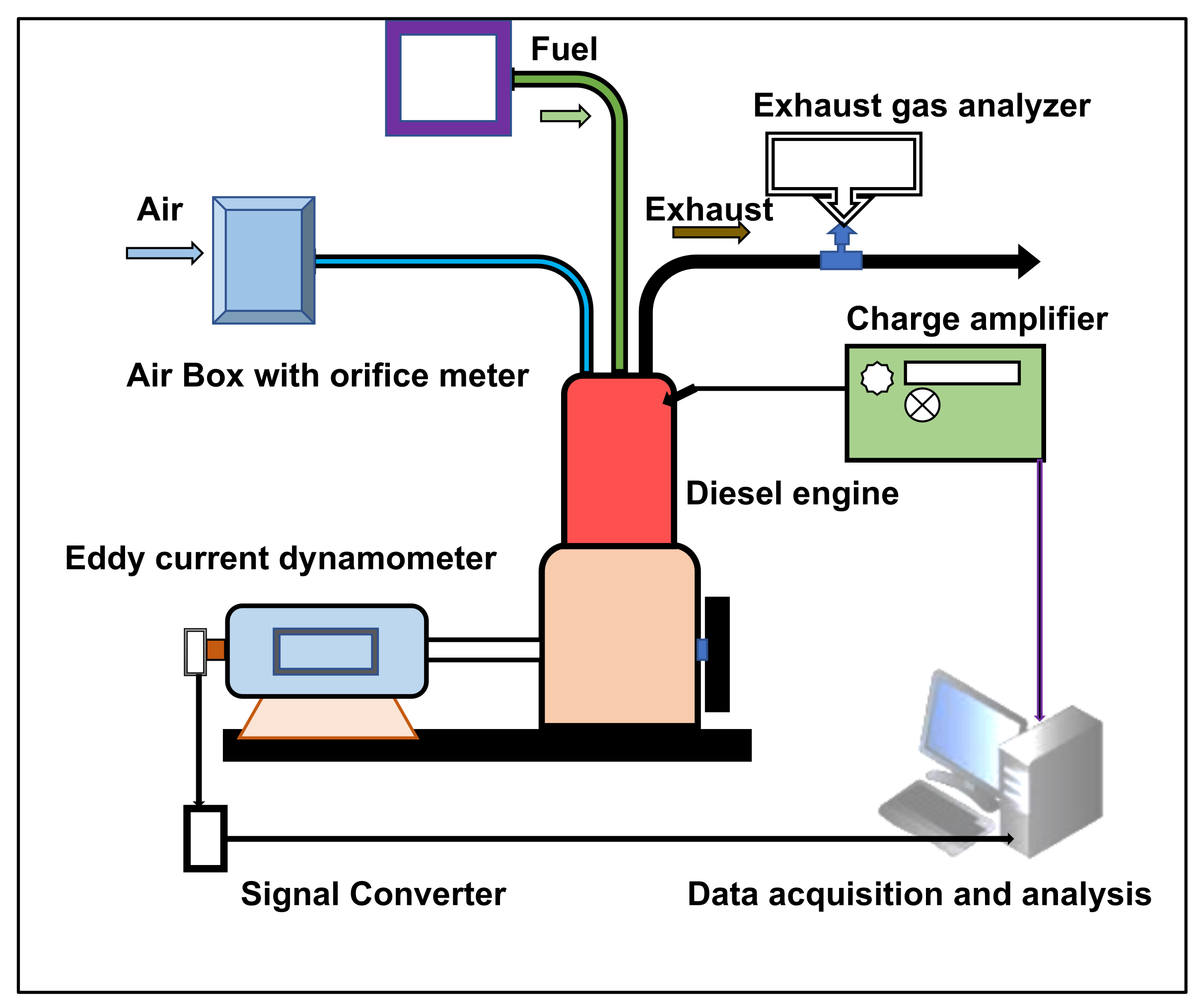
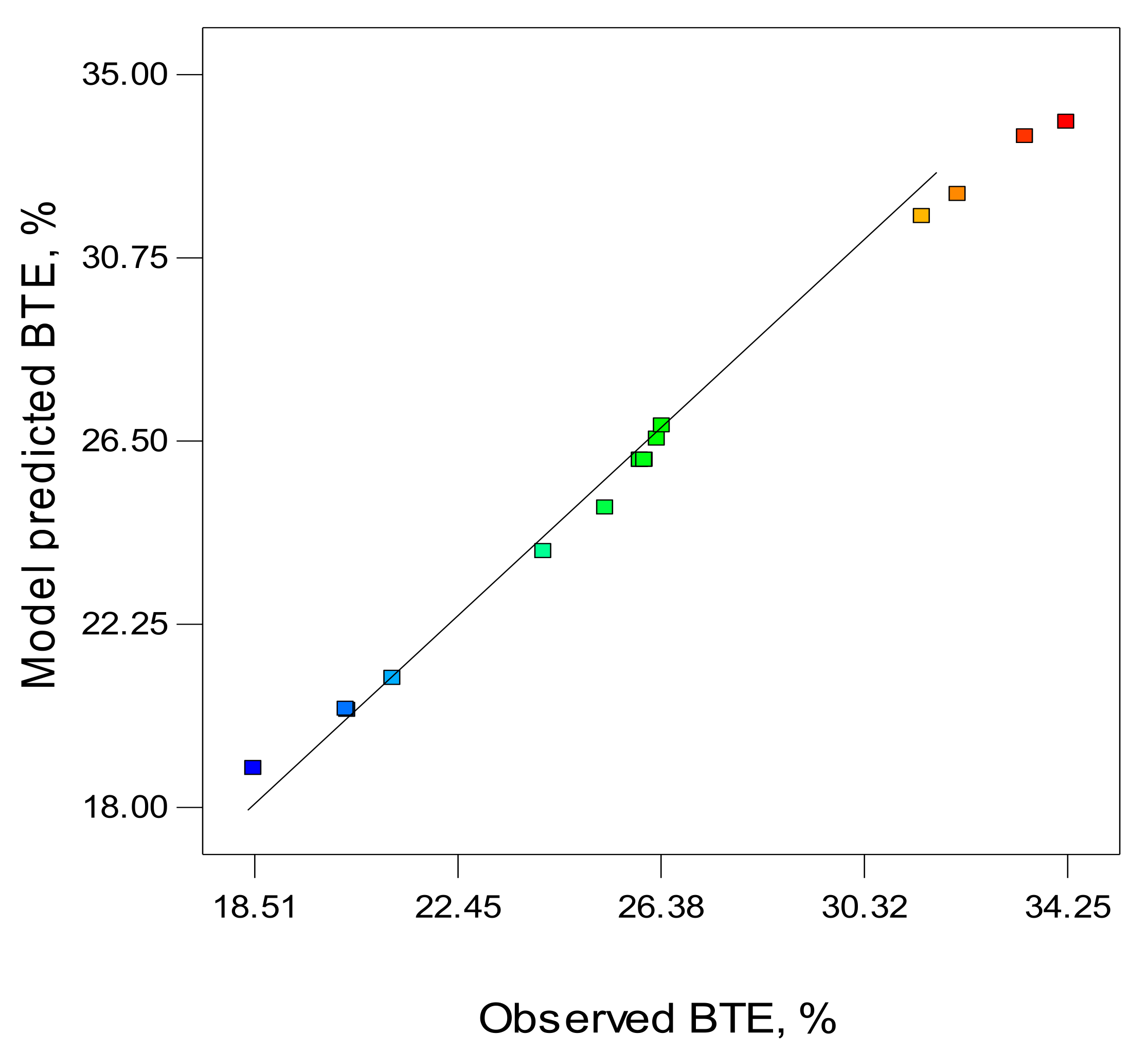

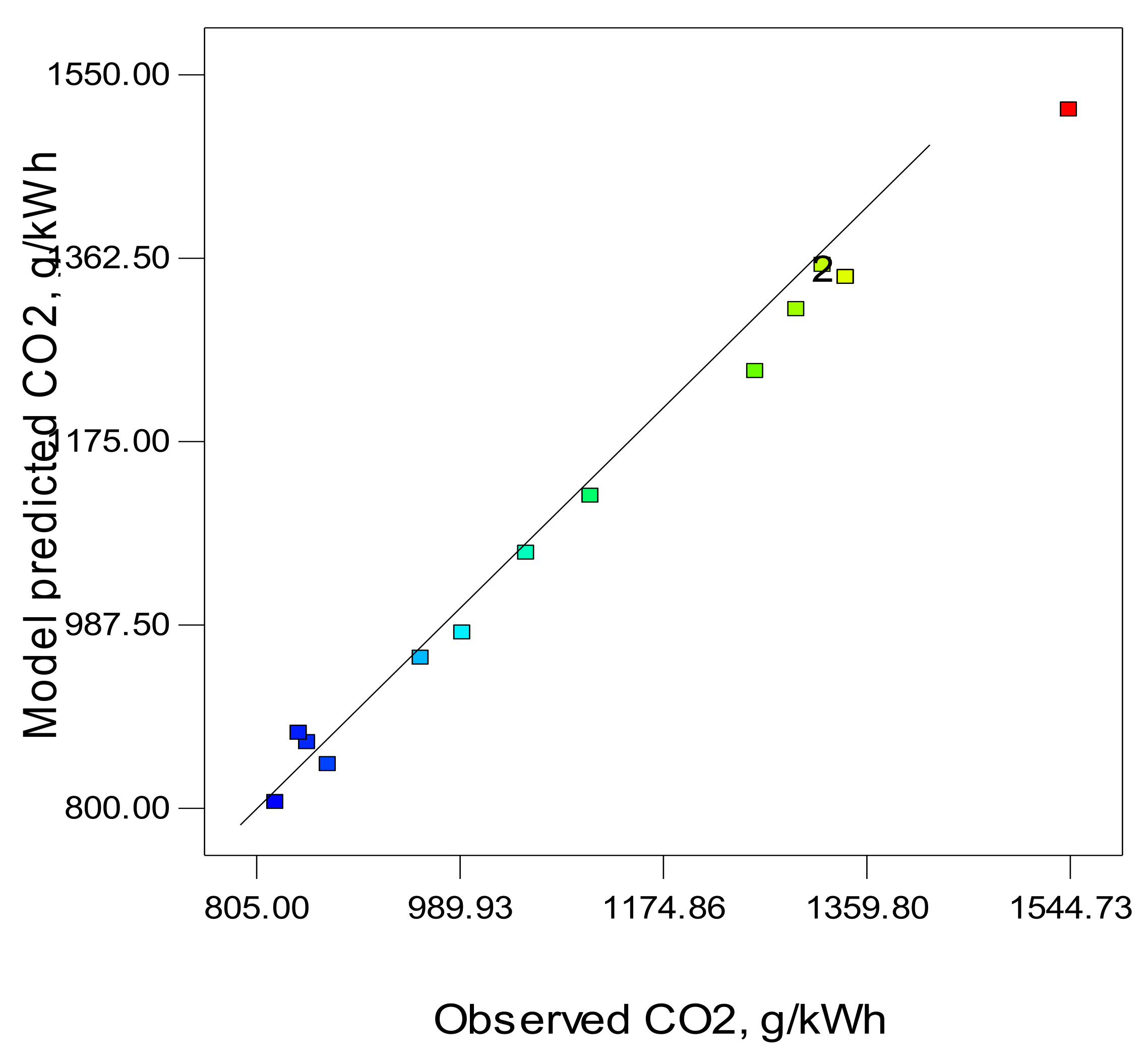
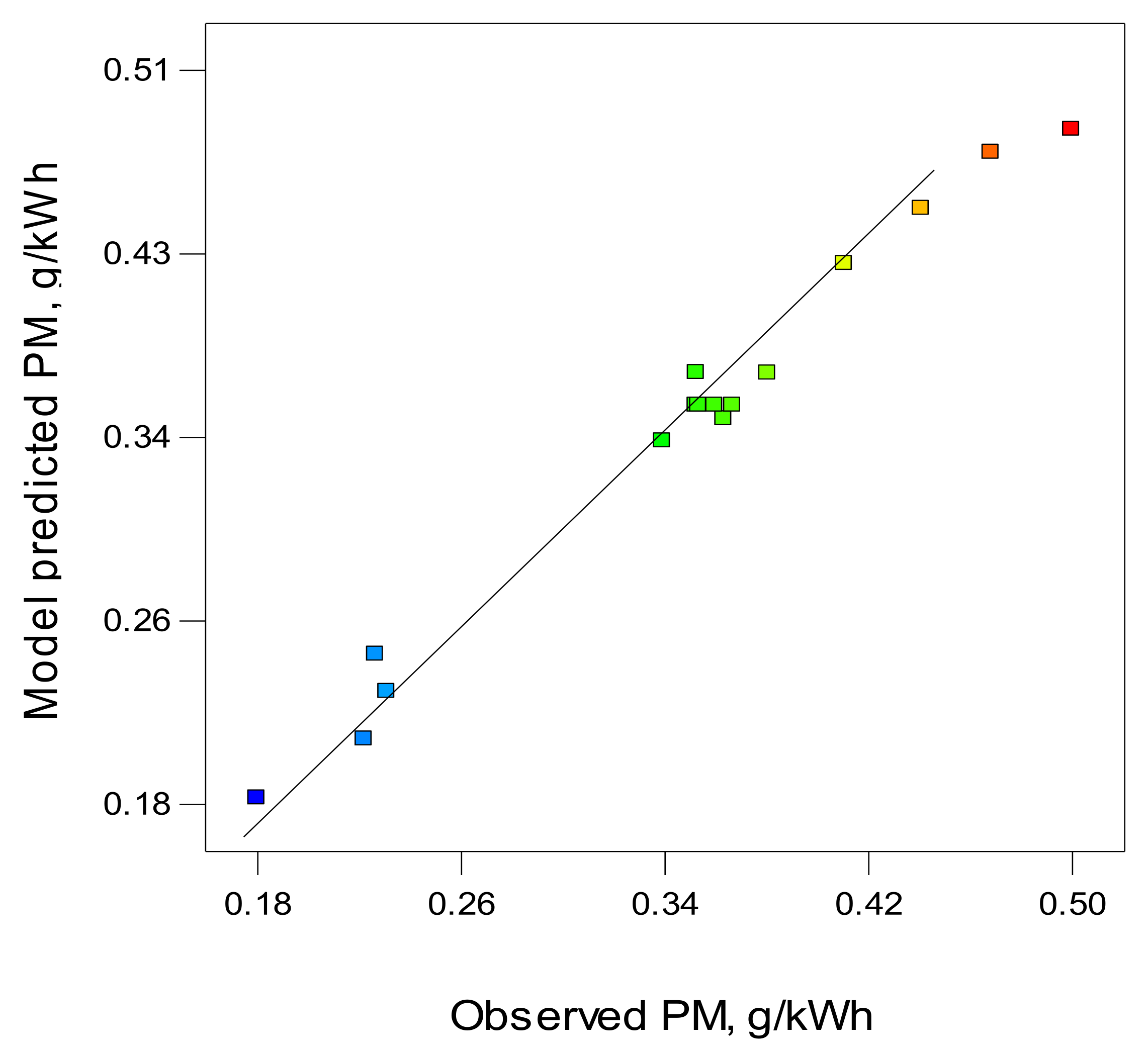
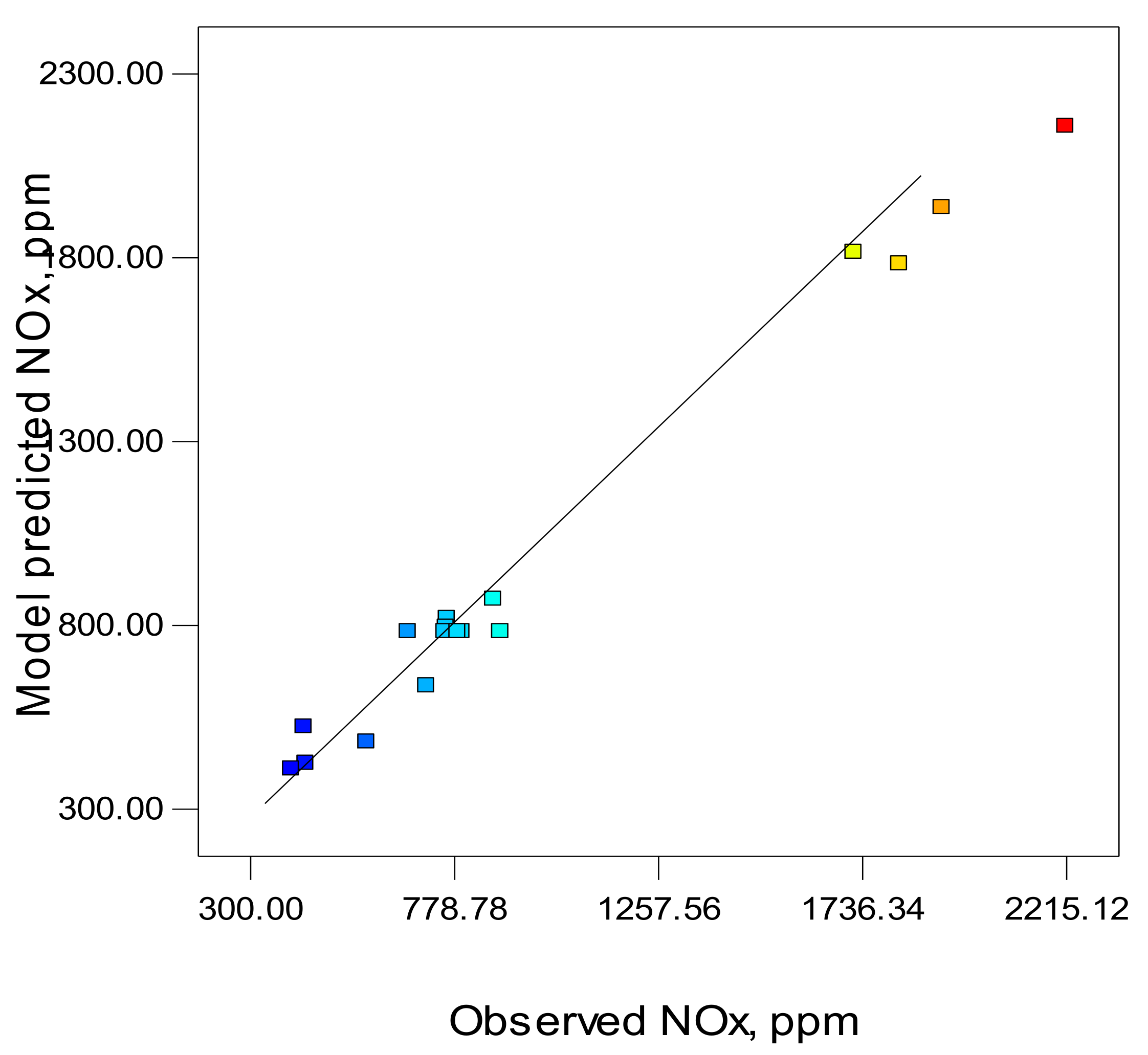

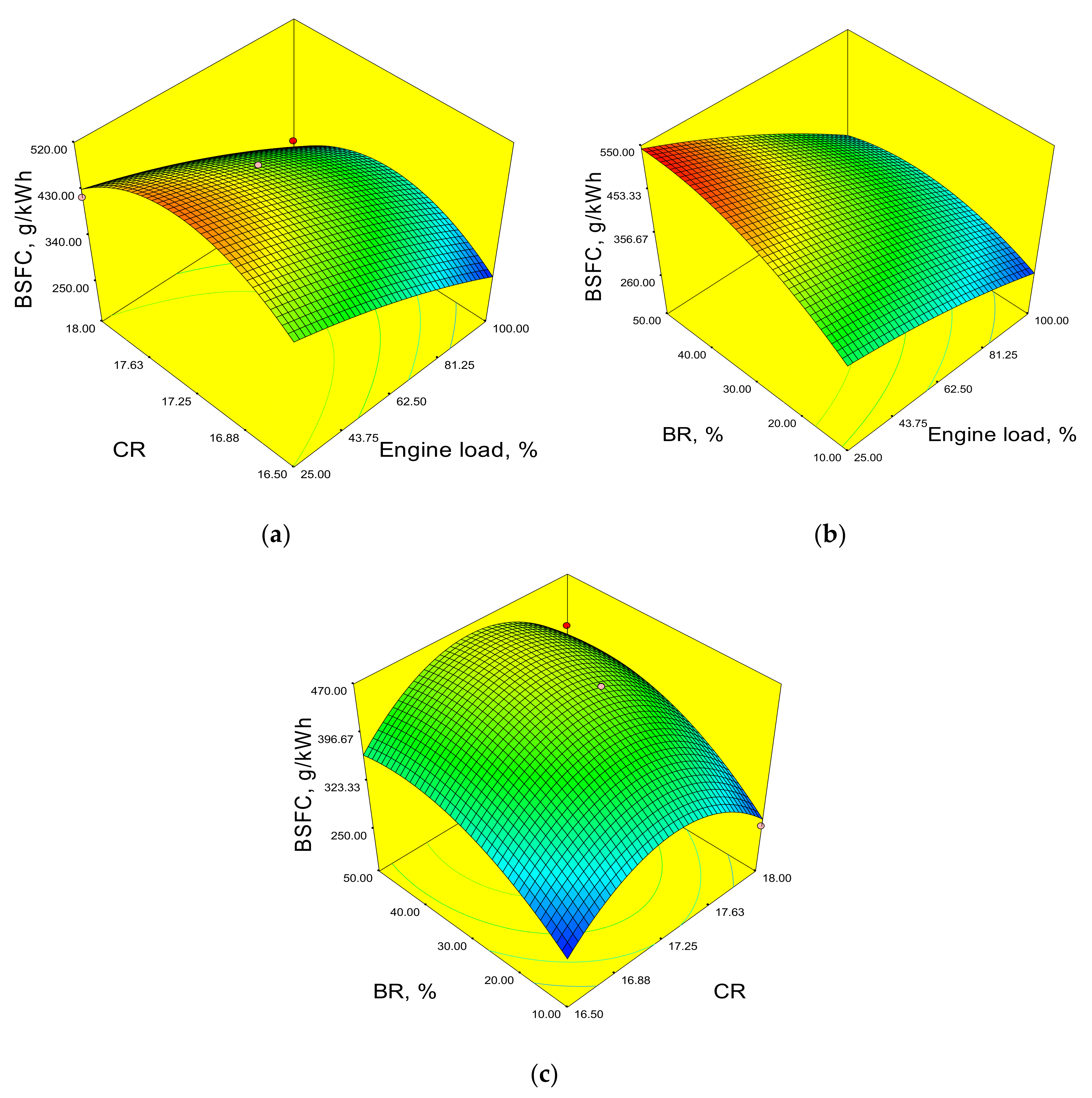
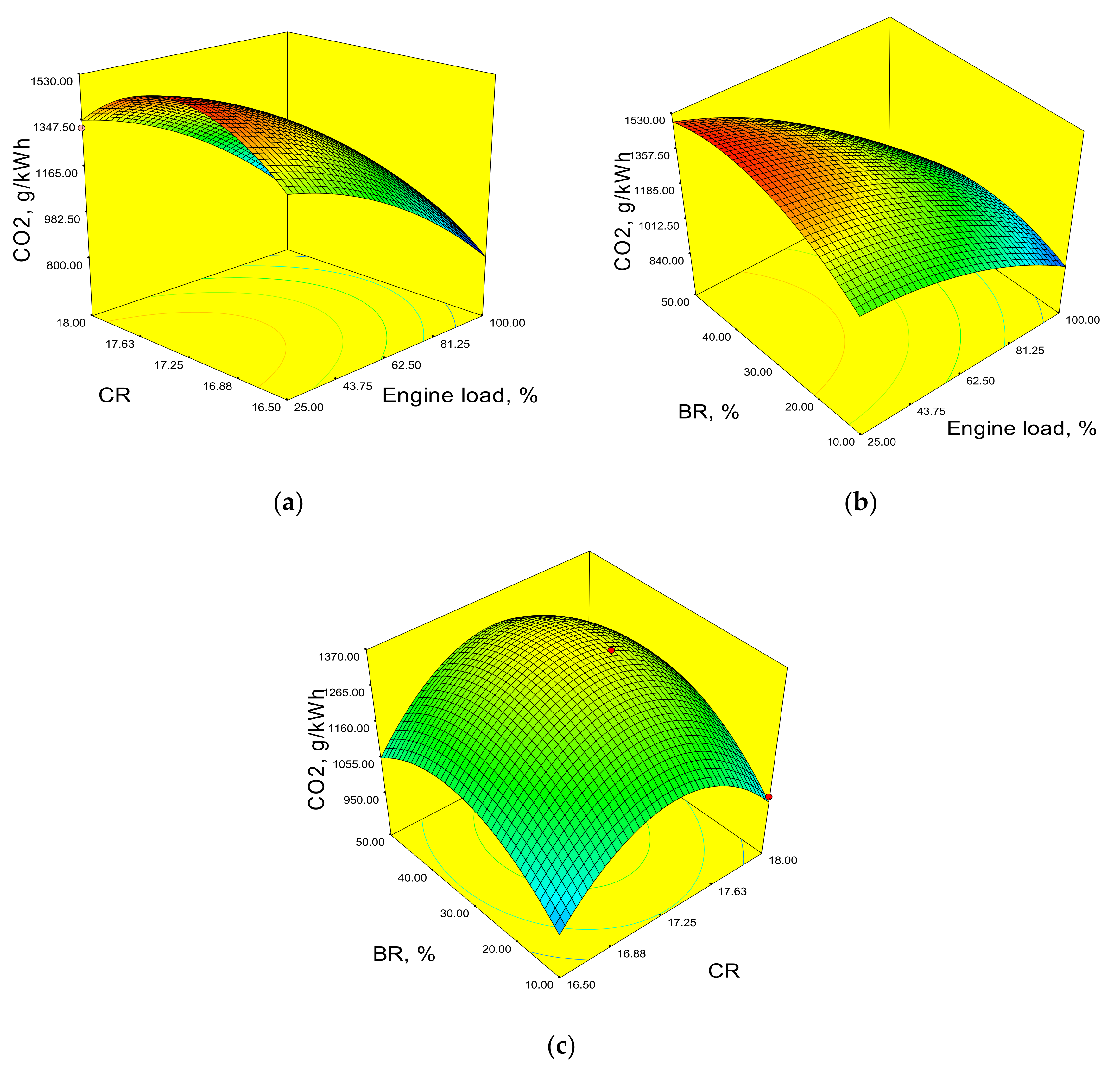
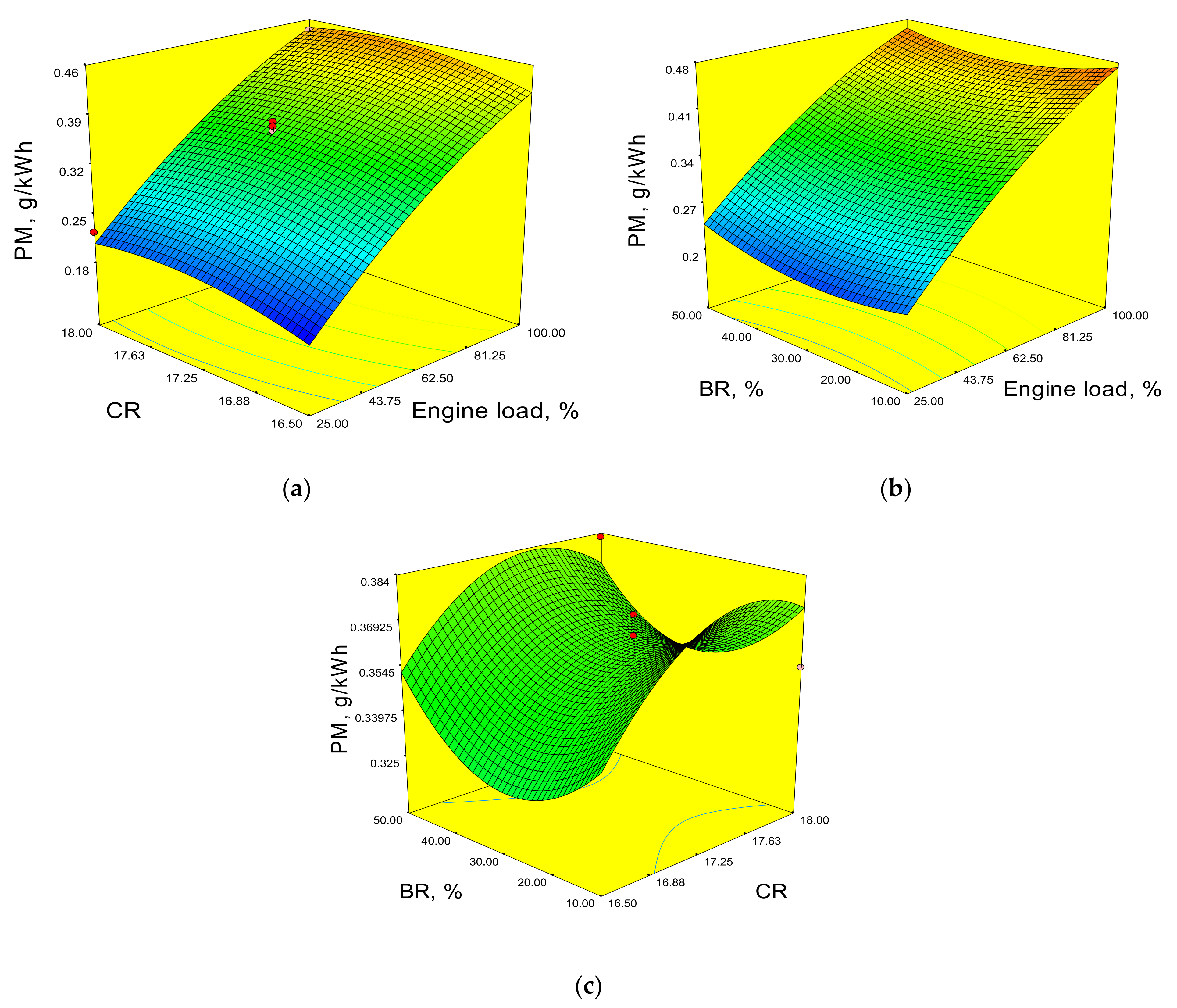


| Parameter | Specification |
|---|---|
| Engine type and make | Variable compression ratio, Kirloskar |
| Loading unit | Eddy current dynamometer type |
| Dynamometer cooling | Water |
| Size and capacity | 87.5 × 110 mm, 661 cm3 |
| Engine Compression ratio | 12–18 |
| Power rating | 3.5 kW @ 1500 rpm |
| Load sensor | Strain gauge type |
| Temperature measurement | Thermocouple type k, and RTD |
| Water flow measurement | Two rotameters |
| Airflow measurement | Orifice meter with air box |
| Characteristics | Unit | Diesel | Algal Biodiesel |
|---|---|---|---|
| Pour point | °C | −18 | −13 |
| Density (15 °C) | kg/m3 | 834 | 863 |
| Cloud point | °C | ×12 | |
| LCV | MJ/kg | 43.62 | 41.14 |
| Cetane index | - | 49 | 55 |
| Fire point, °C | °C | 76 | 146 |
| Kinematic viscosity, @ 20 °C | cST | 3.51 | 4.91 |
| Run No. | Control Factors | Response Variables | ||||||
|---|---|---|---|---|---|---|---|---|
| Engine Load (%) | Compression Ratio | Blending Ratio (%) | BTE (%) | BSFC (g/kWh) | CO2 (g/kWh) | Particulate Matter (g/kWh) | NOx (ppm) | |
| 5 | 25.00 | 17.50 | 10.00 | 21.21 | 400.39 | 1259.63 | 0.23 | 574.80 |
| 11 | 62.50 | 16.50 | 50.00 | 24.13 | 372.59 | 1051.33 | 0.36 | 872.20 |
| 13 | 62.50 | 17.50 | 30.00 | 25.99 | 437.40 | 1341.93 | 0.37 | 889.20 |
| 9 | 62.50 | 16.50 | 10.00 | 26.33 | 252.10 | 955.36 | 0.34 | 763.30 |
| 10 | 62.50 | 18.00 | 10.00 | 26.42 | 253.40 | 993.24 | 0.35 | 761.20 |
| 17 | 62.50 | 17.50 | 30.00 | 26.01 | 438.00 | 1342.00 | 0.35 | 758.20 |
| 15 | 62.50 | 17.50 | 30.00 | 26.0 | 437.30 | 1341.81 | 0.36 | 798.10 |
| 4 | 100.00 | 18.00 | 30.00 | 33.45 | 283.94 | 870.99 | 0.44 | 1825.10 |
| 8 | 100.00 | 17.50 | 50.00 | 31.46 | 302.04 | 852.18 | 0.47 | 1718.40 |
| 6 | 100.00 | 17.50 | 10.00 | 34.25 | 268.47 | 844.54 | 0.50 | 1925.10 |
| 16 | 62.50 | 17.50 | 30.00 | 26.09 | 437.50 | 1341.90 | 0.36 | 788.40 |
| 2 | 100.00 | 16.50 | 30.00 | 32.15 | 268.38 | 823.24 | 0.41 | 2215.10 |
| 3 | 25.00 | 18.00 | 30.00 | 20.33 | 418.53 | 1320.81 | 0.22 | 427.60 |
| 14 | 62.50 | 17.50 | 30.00 | 26.08 | 437.40 | 1341.93 | 0.36 | 672.10 |
| 7 | 25.00 | 17.50 | 50.00 | 18.51 | 547.44 | 1544.72 | 0.23 | 431.90 |
| 1 | 25.00 | 16.50 | 30.00 | 20.30 | 422.74 | 1296.93 | 0.18 | 398.20 |
| 12 | 62.50 | 18.00 | 50.00 | 25.33 | 393.33 | 1109.84 | 0.38 | 715.30 |
| Measured Parameter | Range | Accuracy | Uncertainty |
|---|---|---|---|
| Load | 0–50 kg | ±1 kg | ±0.02% |
| Temperature | 0–900 °C | ±°C | ±0.15 |
| Speed | 0–10,000 rpm | ±10 rpm | ±1% |
| Fuel flow | 1–30 cc | ±0.1 cc | ±0.5% |
| CO2 | 0 to 20% by volume | ±0.03 Vol% | ±0.2% |
| PM | 0 to 20,000 ppm | ±0.01 Vol% | ±0.2% |
| NOx | 0 to 5000 ppm | ±1 ppm | ±0.1% |
| Calculated Parameter | Uncertainty | ||
| BTE | -- | -- | ±1.2% |
| BSFC | -- | -- | ±0.8% |
| BP | -- | -- | ±1.12% |
| Parameter | BTE | BSFC | ||
|---|---|---|---|---|
| Model Source | F-Value | p-Value Prob > F | F-Value | p-Value Prob > F |
| Model | 338.01 | <0.0001 | 118,697.6 | <0.0001 |
| X-Load | 302.83 | <0.0001 | 38,195.36 | <0.0001 |
| Y-CR | 0.8640 | 0.0305 | 17,479.06 | <0.0001 |
| Z-BR | 9.66 | <0.0001 | 16,066.81 | 0.0001 |
| XY | 0.4918 | 0.0807 | 6.02 | 0.8877 |
| XZ | 0.0026 | 0.8873 | 3219.428 | 0.0116 |
| YZ | 0.1292 | 0.3305 | 8.928853 | 0.8635 |
| X2 | 1.86 | 0.0054 | 789.8411 | 0.1373 |
| Y2 | 0.0044 | 0.8531 | 21,803.59 | <0.0001 |
| Z2 | 0.4987 | <0.0001 | 8240.282 | 0.0010 |
| Parameter | CO2 | PM | NOx | |||
|---|---|---|---|---|---|---|
| Model Source | F-Value | p-Value Prob > F | F-Value | p-Value Prob > F | F-Value | p-Value Prob > F |
| Model | 8.377 × 105 | <0.0001 | 0.122003 | <0.0001 | 5.116 × 106 | <0.0001 |
| X-Load | 4.889 × 105 | <0.0001 | 0.077988 | <0.0001 | 4.295 × 106 | <0.0001 |
| Y-CR | 3528.00 | 0.0633 | 0.003078 | 0.0107 | 33,741.53 | 0.1039 |
| Z-BR | 29,047.49 | 0.0004 | 5.8 × 10−5 | 0.6499 | 5538.13 | 0.4737 |
| XY | 11.11 | 0.9050 | 7.46 × 10−7 | 0.9586 | 62,972.26 | 0.0379 |
| XZ | 19,243.24 | 0.0013 | 0.000183 | 0.4276 | 1018.57 | 0.7549 |
| YZ | 273.90 | 0.5585 | 2.69 × 10−5 | 0.7563 | 11,852.69 | 0.3047 |
| X2 | 29,036.73 | 0.0004 | 0.00224 | 0.0215 | 7.076 × 105 | <0.0001 |
| Y2 | 1.2 × 105 | <0.0001 | 0.001057 | 0.0827 | 55.36 | 0.9418 |
| Z2 | 75157.45 | <0.0001 | 0.002092 | 0.0248 | 3442.60 | 0.5694 |
| BTE (%) | BSFC (g/kWh) | CO2(g/kWh) | PM (g/kWh) | NOx (ppm) | |||||
|---|---|---|---|---|---|---|---|---|---|
| Obs. | Pred. | Obs | Pred. | Obs. | Pred. | Obs. | Pred. | Obs. | Pred. |
| 21.21 | 20.97 | 400.39 | 379.37 | 1259.63 | 1245.57 | 0.23 | 0.25 | 574.80 | 571.21 |
| 24.13 | 23.92 | 372.59 | 368.81 | 1051.33 | 1060.21 | 0.36 | 0.33 | 872.20 | 868.93 |
| 25.99 | 26.04 | 437.40 | 437.52 | 1341.93 | 1341.91 | 0.37 | 0.35 | 889.20 | 882.22 |
| 26.33 | 26.52 | 252.10 | 258.55 | 955.36 | 952.67 | 0.34 | 0.34 | 763.30 | 816.96 |
| 26.42 | 26.83 | 253.40 | 266.90 | 993.24 | 978.56 | 0.35 | 0.35 | 761.20 | 763.04 |
| 26.01 | 26.04 | 438.00 | 437.52 | 1342.00 | 1341.91 | 0.35 | 0.35 | 758.20 | 761.22 |
| 26.0 | 26.04 | 437.30 | 437.52 | 1341.81 | 1341.91 | 0.36 | 0.35 | 798.10 | 781.22 |
| 33.45 | 33.54 | 283.94 | 269.29 | 870.99 | 843.75 | 0.44 | 0.45 | 1825.10 | 1821.22 |
| 31.46 | 31.69 | 302.04 | 323.06 | 852.18 | 866.24 | 0.47 | 0.48 | 1718.40 | 1812.99 |
| 34.25 | 33.88 | 268.47 | 269.54 | 844.54 | 875.95 | 0.50 | 0.49 | 1925.10 | 1934.22 |
| 26.09 | 26.04 | 437.50 | 437.52 | 1341.90 | 1341.91 | 0.36 | 0.35 | 788.40 | 781.22 |
| 32.15 | 32.20 | 268.38 | 260.94 | 823.24 | 805.00 | 0.41 | 0.43 | 2215.10 | 2210.35 |
| 20.33 | 20.23 | 418.53 | 435.85 | 1320.81 | 1354.25 | 0.22 | 0.21 | 427.60 | 434.96 |
| 26.08 | 26.04 | 437.40 | 437.52 | 1341.93 | 1341.91 | 0.36 | 0.35 | 672.10 | 781.22 |
| 18.51 | 18.89 | 547.44 | 546.37 | 1544.72 | 1513.30 | 0.23 | 0.24 | 431.90 | 422.81 |
| 20.30 | 20.26 | 422.74 | 427.51 | 1296.93 | 1309.00 | 0.18 | 0.19 | 398.20 | 407.59 |
| 25.33 | 24.93 | 393.33 | 377.16 | 1109.84 | 1118.32 | 0.38 | 0.34 | 715.30 | 633.08 |
| Indices | BTE | BSFC | CO2 | PM | NOx |
|---|---|---|---|---|---|
| R | 0.9989 | 0.9917 | 0.9969 | 0.9820 | 0.9972 |
| R2 | 0.9975 | 0.9836 | 0.9939 | 0.9644 | 0.9944 |
| MAPD | 0.7% | 2.3% | 1.2% | 4.4% | 3.1% |
| NSE | 0.9988 | 0.984 | 0.994 | 0.965 | 0.9944 |
| RMSE | 0.22 | 10.78 | 17.29 | 0.016 | 42.87 |
| Theil’s U1 | 0.0042 | 0.014 | 0.0073 | 0.022 | 0.019 |
| Theil’s U2 | 0.0449 | 0.092 | 0.059 | 0.1804 | 0.125 |
| Optimized Control Factors | Outputs | |||||||
|---|---|---|---|---|---|---|---|---|
| Engine Load | CR | B Ratio | BTE | BSFC | CO2 | PM | NOx | |
| 81.2% | 17.5 | 10% | Pred. results | 30.14 (%) | 307.36 (g/kWh) | 1030. 99(g/kWh) | 0.42 9(g/kWh) | 1261.75 (ppm) |
| Exp. output | 30.36 (%) | 302.45 (g/kWh) | 1051.25 (g/kWh) | 0.411 (g/kWh) | 1287.4 (ppm) | |||
| %Error | 7.29% | 1.6% | 1.96% | 4.19% | 2.03% | |||
Publisher’s Note: MDPI stays neutral with regard to jurisdictional claims in published maps and institutional affiliations. |
© 2021 by the authors. Licensee MDPI, Basel, Switzerland. This article is an open access article distributed under the terms and conditions of the Creative Commons Attribution (CC BY) license (https://creativecommons.org/licenses/by/4.0/).
Share and Cite
Sharma, P.; Chhillar, A.; Said, Z.; Memon, S. Exploring the Exhaust Emission and Efficiency of Algal Biodiesel Powered Compression Ignition Engine: Application of Box–Behnken and Desirability Based Multi-Objective Response Surface Methodology. Energies 2021, 14, 5968. https://doi.org/10.3390/en14185968
Sharma P, Chhillar A, Said Z, Memon S. Exploring the Exhaust Emission and Efficiency of Algal Biodiesel Powered Compression Ignition Engine: Application of Box–Behnken and Desirability Based Multi-Objective Response Surface Methodology. Energies. 2021; 14(18):5968. https://doi.org/10.3390/en14185968
Chicago/Turabian StyleSharma, Prabhakar, Ajay Chhillar, Zafar Said, and Saim Memon. 2021. "Exploring the Exhaust Emission and Efficiency of Algal Biodiesel Powered Compression Ignition Engine: Application of Box–Behnken and Desirability Based Multi-Objective Response Surface Methodology" Energies 14, no. 18: 5968. https://doi.org/10.3390/en14185968
APA StyleSharma, P., Chhillar, A., Said, Z., & Memon, S. (2021). Exploring the Exhaust Emission and Efficiency of Algal Biodiesel Powered Compression Ignition Engine: Application of Box–Behnken and Desirability Based Multi-Objective Response Surface Methodology. Energies, 14(18), 5968. https://doi.org/10.3390/en14185968








